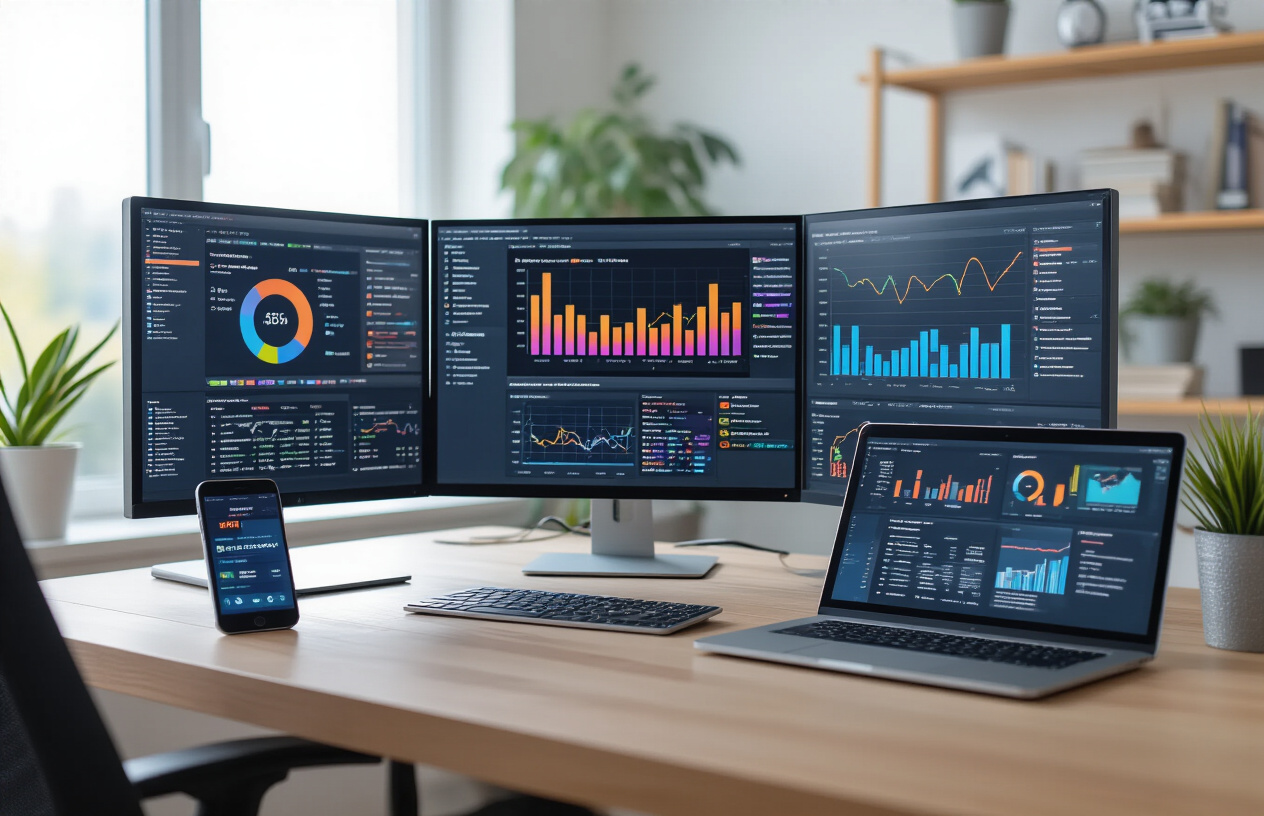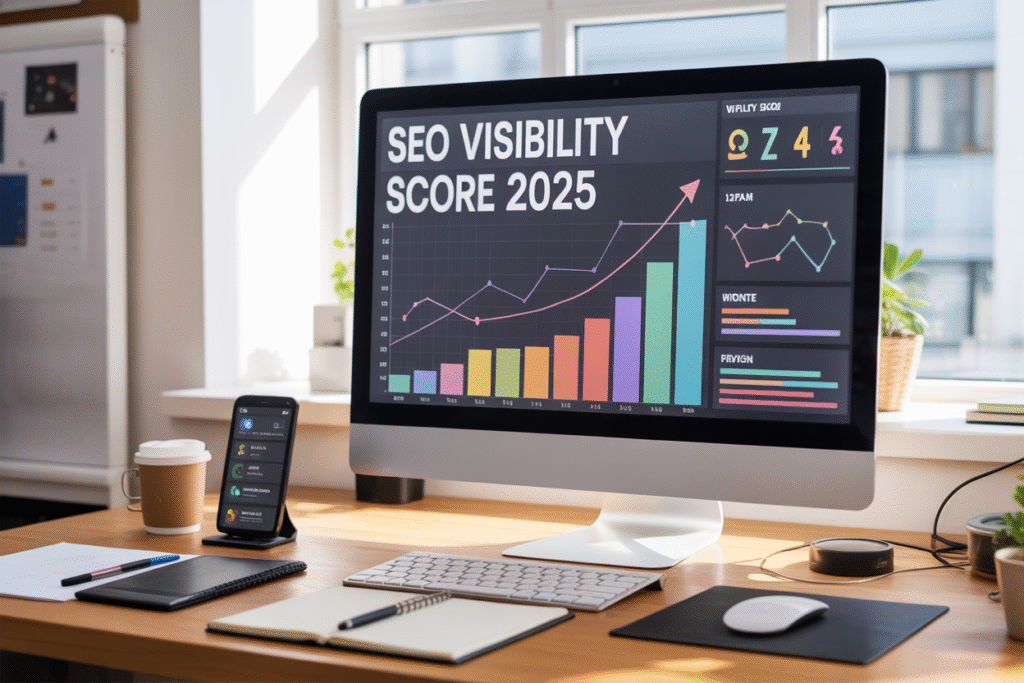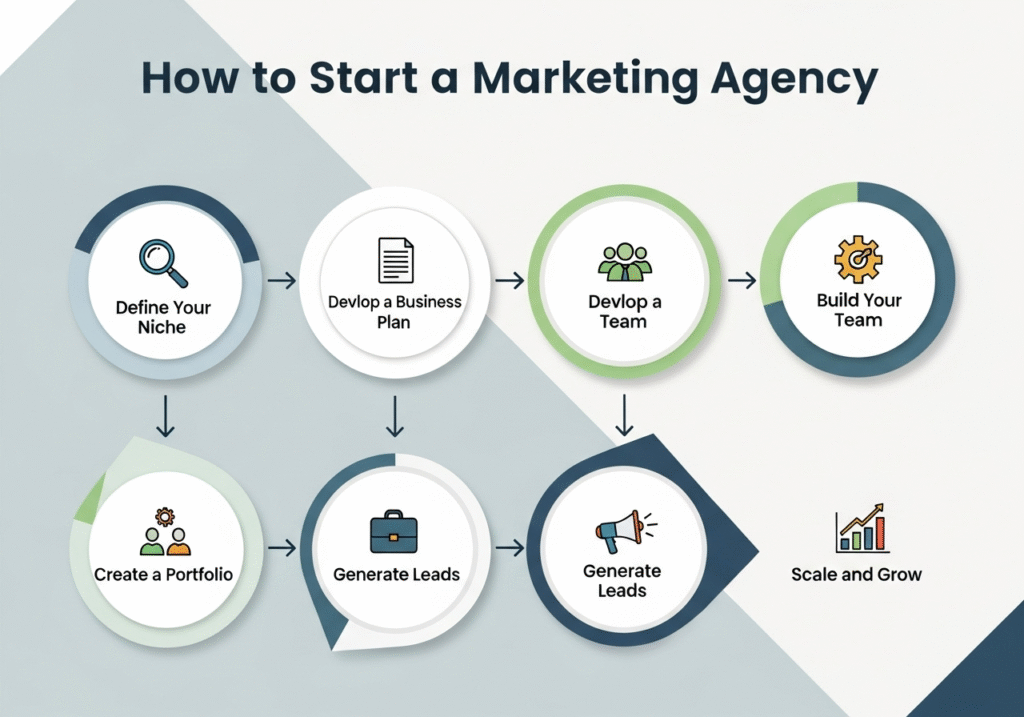Your website could be ranking for thousands of keywords, but what does that actually mean for your business? If you’re scratching your head wondering what is a good SEO visibility score and how it impacts your organic traffic, you’re not alone.
This guide is for business owners, digital marketers, and SEO professionals who want to understand how SEO visibility scores work and use them to boost their search performance. We’ll break down the confusing world of SEO performance metrics and show you exactly what these numbers mean for your website.
You’ll discover the industry benchmarks that separate strong performers from struggling sites, plus learn which SEO analysis tools give you the most accurate visibility measurements.
We’ll also cover the key factors that can make or break your SEO ranking score and share proven strategies to improve SEO visibility that actually move the needle.
Understanding SEO Visibility Score Fundamentals

Definition and Core Components of SEO Visibility Score
SEO visibility score is a comprehensive metric that measures how well your website performs in search engine results for relevant keywords. Think of it as a report card that tells you what percentage of potential organic traffic you’re actually capturing compared to the maximum possible traffic available for your keyword portfolio.
The core components that make up your SEO visibility score include:
- Keyword rankings across all tracked terms – Your position for each keyword directly impacts your visibility percentage
- Search volume data – Higher search volume keywords carry more weight in the calculation
- Click-through rates (CTR) – Expected traffic based on your ranking positions
- SERP features presence – Featured snippets, local packs, and other rich results factor into visibility
- Keyword difficulty and competition levels – More competitive terms may influence scoring algorithms differently
Most SEO analysis tools calculate visibility scores using proprietary algorithms that combine these elements. A visibility score typically ranges from 0% to 100%, where 100% represents perfect visibility for all your tracked keywords – though achieving this is virtually impossible in practice.
How Visibility Score Differs from Traditional SEO Metrics
Traditional SEO performance metrics like individual keyword rankings or domain authority only tell part of the story. Your SEO visibility score provides a holistic view that traditional metrics simply can’t match.
Here’s how visibility scoring stands apart from conventional measurements:
| Traditional Metrics | Visibility Score |
|---|---|
| Tracks individual keyword positions | Aggregates performance across entire keyword portfolio |
| Static ranking data | Dynamic scoring that reflects search volume and competition |
| Difficult to benchmark against competitors | Allows direct competitor comparison |
| Doesn’t account for traffic potential | Weighted by actual search volume and CTR expectations |
| Limited actionable insights | Provides clear performance trends and opportunities |
While traditional rankings might show you’re #3 for a specific keyword, your visibility score reveals whether that ranking actually drives meaningful website visibility SEO impact. A high-volume keyword ranking at position #5 could contribute more to your visibility score than a low-volume keyword ranking at position #1.
SEO score meaning goes beyond simple position tracking to reflect real business value. If your visibility score drops, you know your overall organic search presence has weakened, even if some individual keywords maintain their positions.
Key Factors That Influence Your Visibility Score
Your SEO visibility score fluctuates based on several critical factors that search engines and tracking tools consider when calculating your overall performance.
Search algorithm updates can dramatically impact visibility scores overnight. When Google rolls out core updates, websites may see significant score changes even without making any modifications to their content or SEO strategy.
Keyword portfolio composition plays a huge role in score stability. Websites tracking a diverse mix of keywords typically see more stable scores than those focusing on just a few high-volume terms. The breadth and relevance of your tracked keywords directly influence your SEO ranking score.
Competitor activity constantly shifts the landscape. When competitors improve their content, build stronger backlinks, or optimize their pages more effectively, your relative visibility can decrease even if your absolute performance remains unchanged.
Seasonal search patterns create predictable visibility fluctuations for many industries. E-commerce sites often see visibility scores peak during holiday seasons, while B2B companies might experience different patterns aligned with business cycles.
Technical SEO factors like site speed, mobile responsiveness, and crawling issues can suppress your visibility score regardless of your content quality. Search engines can’t properly index and rank pages that have technical problems.
Content freshness and relevance increasingly impact visibility calculations. Pages that become outdated or lose relevance to user search intent may see their contribution to overall visibility scores diminish over time.
Understanding these factors helps explain why improve SEO visibility efforts require a comprehensive approach rather than focusing on individual ranking improvements.
SEO Visibility Score Benchmarks and Industry Standards

What Constitutes a Good Visibility Score by Industry?
Different industries have vastly different benchmarks for what qualifies as a strong SEO visibility score. E-commerce and retail sectors typically see scores ranging from 15-40% as competitive, while B2B software companies often consider scores between 5-15% as solid performance.
Healthcare and legal industries face stricter competition, making scores above 10% particularly impressive. Local service businesses like plumbing or landscaping can achieve excellent results with scores as low as 3-8% in their target markets.
Technology startups and SaaS platforms need higher visibility scores, often aiming for 20-50% to compete effectively with established players. Financial services and insurance companies operate in highly competitive spaces where scores above 25% indicate strong market presence.
Media and publishing websites typically require visibility scores exceeding 30% to maintain meaningful traffic levels.
| Industry | Good Score Range | Competitive Score | Excellent Score |
|---|---|---|---|
| E-commerce | 15-25% | 25-40% | 40%+ |
| B2B Software | 5-10% | 10-15% | 15%+ |
| Local Services | 3-6% | 6-8% | 8%+ |
| Healthcare | 8-12% | 12-18% | 18%+ |
| Finance | 15-20% | 20-25% | 25%+ |
Small Business vs Enterprise Visibility Score Expectations
Small businesses and enterprises operate under completely different SEO visibility expectations. Small businesses with limited budgets and resources should focus on achieving visibility scores between 2-10% within their local or niche markets.
These businesses benefit more from targeted, long-tail keyword strategies that drive qualified traffic rather than competing for broad, high-volume terms. Enterprise companies have the resources to target competitive keywords and should aim for visibility scores of 15-50% or higher.
Large corporations can invest in comprehensive content strategies, technical SEO improvements, and link-building campaigns that smaller competitors cannot match.
The key difference lies in market scope. Small businesses excel when they dominate specific geographic areas or specialized niches, even with lower overall visibility scores. A local bakery achieving 5% visibility in their city might outperform a national chain with 25% visibility when measuring actual business impact.
Enterprise websites typically track visibility across multiple markets, product lines, and geographic regions. Their SEO performance metrics need to account for brand recognition, which naturally boosts visibility scores through branded search traffic.
Geographic and Market-Specific Score Variations
SEO visibility scores fluctuate dramatically based on geographic location and market dynamics. Urban markets like New York or Los Angeles require higher visibility scores due to intense competition, while rural or smaller metropolitan areas allow businesses to succeed with lower scores.
International markets present unique challenges. English-speaking markets (US, UK, Australia) typically demand higher visibility scores because of market saturation. Emerging markets or non-English speaking regions often provide opportunities for lower scores to generate meaningful traffic.
Local search modifiers significantly impact website visibility SEO requirements. A restaurant targeting “pizza delivery Chicago” faces different competition levels than one focusing on “pizza delivery Springfield Illinois.” Market size directly correlates with the visibility score needed for success.
Seasonal markets also affect score benchmarks. Tourism-related businesses need higher visibility during peak seasons but can maintain lower scores during off-peak periods. Retail businesses require elevated visibility during holiday shopping periods.
Competitive Analysis Framework For Score Evaluation
Building an effective competitive analysis framework starts with identifying direct and indirect competitors within your market space. Direct competitors target identical keywords and serve the same customer base, while indirect competitors may overlap in some keyword areas but serve different primary purposes.
Use SEO analysis tools to benchmark your visibility score against 5-10 key competitors. Track their performance over 6-12 months to understand seasonal patterns and growth trends. Look for competitors with similar business models and target audiences rather than simply focusing on the largest players in your industry.
Create a scoring matrix that weighs different factors:
- Domain authority and age
- Content volume and quality
- Technical SEO implementation
- Link building strategies
- Local SEO optimization
Regular competitive analysis should include monitoring new entrants to your market space. Startups and established companies entering your niche can quickly disrupt SEO visibility benchmark standards. Track competitor content strategies, keyword targeting changes, and technical improvements that might affect their visibility scores.
Set up automated alerts for significant competitor visibility score changes. Sudden improvements often indicate new SEO strategies worth investigating, while drops might reveal opportunities to capture market share.
Tools and Platforms for Measuring SEO Visibility

Leading SEO Tools For Visibility Score Tracking
Professional SEO analysis tools provide the most accurate and comprehensive visibility score measurements. Semrush stands out as a top choice, offering detailed visibility scores based on your website’s ranking positions across thousands of keywords. Their visibility metric considers both keyword rankings and search volume, giving you a weighted score that reflects actual traffic potential.
Ahrefs provides another excellent option with their organic traffic value metric, which closely mirrors SEO visibility calculations. Their tool tracks your website’s performance across multiple search engines and provides historical data to monitor trends over time.
Sistrix pioneered the visibility index concept and remains a leader in European markets. Their scoring system is particularly valuable for understanding competitive positioning and market share analysis.
Moz Pro offers domain authority and page authority metrics alongside visibility tracking features. While not exactly the same as traditional visibility scores, these metrics correlate strongly with search performance and provide actionable insights for improvement.
SE Ranking delivers comprehensive visibility tracking at competitive pricing, making it accessible for smaller businesses. Their platform includes keyword position tracking, competitor analysis, and automated reporting features.
For enterprise-level needs, BrightEdge and Conductor provide sophisticated visibility measurement capabilities with advanced analytics and custom reporting options.
Free vs Paid Visibility Measurement Options
Free tools offer basic visibility insights but come with significant limitations. Google Search Console provides the most valuable free data, showing your actual search performance, impressions, and click-through rates. While it doesn’t calculate a specific visibility score, you can derive similar insights from the performance reports.
Google Analytics 4 helps track organic traffic trends and user behavior, giving you indirect visibility measurements through traffic patterns and engagement metrics. Ubersuggest offers limited free searches daily, including basic keyword ranking data that contributes to visibility calculations.
Paid tools deliver comprehensive visibility tracking with several key advantages:
- Historical data access spanning months or years
- Competitor visibility comparisons across your industry
- Keyword-level tracking for thousands of terms simultaneously
- Automated reporting and alert systems
- Advanced filtering and segmentation options
- API access for custom integrations
The investment in paid tools typically pays off through more accurate data and time-saving automation features. Most businesses find that even basic paid plans provide significantly better visibility insights than free alternatives.
Setting Up Proper Tracking and Monitoring Systems
Effective SEO visibility monitoring requires a structured approach to data collection and analysis. Start by identifying your primary keyword set – typically 50-200 terms that represent your core business objectives. Include brand terms, product keywords, and industry-specific phrases that drive meaningful traffic to your website.
Configure your chosen tool to track these keywords across relevant geographic markets and device types. Mobile and desktop visibility can vary significantly, so separate tracking helps identify optimization opportunities.
Establish baseline measurements before implementing changes. Most tools require 2-4 weeks of data collection to establish reliable visibility trends. Set up automated weekly or monthly reports to track progress without manual effort.
Create competitor benchmarking by adding 3-5 direct competitors to your monitoring dashboard. This context helps interpret whether visibility changes reflect your performance improvements or broader market shifts.
Set up alert systems for significant visibility drops – typically 20% or more week-over-week changes warrant immediate investigation. These alerts help you respond quickly to algorithm updates or technical issues affecting your search performance.
Integrate visibility data with other marketing metrics using tools like Google Data Studio or your preferred analytics platform. Connecting visibility scores with traffic, conversions, and revenue provides complete performance visibility and helps demonstrate SEO ROI to stakeholders.
Regular auditing ensures your tracking system remains accurate. Review your keyword list quarterly, removing irrelevant terms and adding new opportunities as your business evolves.
Factors That Impact Your SEO Visibility Score

Keyword Rankings and Search Volume Influence
Your SEO visibility score takes a direct hit from how well your keywords rank and the search volume behind them. When your target keywords climb higher in search results, your visibility score follows suit. Google rewards sites that rank in positions 1-3 with significantly more visibility points than those buried on page two.
High-volume keywords carry more weight in visibility calculations. A first-page ranking for a keyword with 10,000 monthly searches impacts your score more than ranking for a term with 100 searches. This creates a compounding effect where targeting popular, relevant keywords becomes crucial for improving SEO visibility.
Position changes create immediate visibility fluctuations. Moving from position 5 to position 3 for a competitive keyword can boost your SEO performance metrics substantially. The opposite holds true – dropping rankings tanks your visibility score fast.
Search volume changes throughout the year also affect your scores. Seasonal keywords might spike your visibility during peak months, then drop during off-seasons. Smart SEO professionals track these patterns to understand their website visibility SEO trends.
SERP Features and Rich Snippet Performance
Featured snippets, knowledge panels, and other SERP features dramatically influence your SEO visibility calculations. Landing a featured snippet can multiply your visibility score for that keyword, even if your organic ranking sits lower on the page.
Different SERP features carry varying visibility weights:
| SERP Feature | Visibility Impact | Competition Level |
|---|---|---|
| Featured Snippet | Very High | Extremely High |
| Knowledge Panel | High | Brand-dependent |
| Image Pack | Moderate | Industry-dependent |
| Local Pack | High | Location-based |
| Reviews/Ratings | Moderate | Review-dependent |
Schema markup implementation directly affects your chances of earning these valuable SERP real estate spots. Proper structured data helps search engines understand your content better, increasing your odds of appearing in rich snippets.
Multiple SERP feature appearances for a single keyword can stack visibility benefits. Your site might appear in both organic results and image packs, doubling your visibility impact for that search term.
Brand vs Non-Brand Search Visibility
Brand searches typically show higher visibility scores because your website naturally ranks better for your company name and branded terms. These searches indicate strong brand recognition but don’t always translate to business growth.
Non-brand keyword visibility reveals your true competitive position. Ranking well for industry terms, product categories, and problem-solving keywords demonstrates your site’s authority beyond just brand recognition. These rankings drive new customer acquisition.
SEO analysis tools often separate brand and non-brand visibility metrics because they serve different purposes:
- Brand visibility: Measures brand strength and recognition
- Non-brand visibility: Indicates competitive market position
- Combined visibility: Provides overall SEO ranking score
Balanced visibility across both categories creates sustainable organic growth. Over-reliance on brand terms limits your reach to existing audiences, while strong non-brand visibility opens doors to new customers actively searching for solutions.
Technical SEO Elements Affecting Visibility
Page speed directly correlates with visibility scores. Slow-loading pages lose rankings, which immediately hurts your SEO visibility score. Core Web Vitals have become critical ranking factors that search engines weigh heavily in visibility calculations.
Mobile responsiveness affects visibility since Google uses mobile-first indexing. Sites that don’t display properly on mobile devices see reduced visibility scores across all keywords, not just mobile searches.
Crawlability issues create invisible barriers that tank visibility scores. Broken internal links, poor site architecture, and blocked resources prevent search engines from properly indexing your content.
HTTPS implementation, proper redirects, and clean URL structures contribute to technical health. These foundational elements support your visibility by ensuring search engines can access and trust your content.
Site architecture influences how visibility flows throughout your website. Well-structured internal linking helps distribute authority and improves visibility for deeper pages.
Content Quality and Relevance Factors
Content depth and expertise directly impact your visibility calculations. Comprehensive content that thoroughly covers topics tends to rank higher and maintain those positions longer, creating sustained visibility benefits.
Search intent alignment determines visibility success. Content that matches what users actually want to find performs better in rankings and SEO performance metrics. Misaligned content struggles to maintain visibility even with strong technical SEO.
Content freshness affects visibility differently across industries. News sites need constant updates to maintain visibility, while evergreen content in stable industries can hold rankings longer.
User engagement signals influence visibility scores through metrics like dwell time, bounce rate, and return visits. Content that keeps users engaged sends positive signals to search engines, supporting higher visibility.
Topical authority building through content clusters enhances overall visibility. Sites that demonstrate expertise across related topics often see improved visibility for their entire content ecosystem, not just individual pages.
Strategies to Improve Your SEO Visibility Score

Keyword Research and Optimization Techniques
Smart keyword research forms the foundation of any successful SEO visibility improvement strategy. Start by identifying high-value keywords that your target audience actively searches for using tools like Ahrefs, SEMrush, or Google Keyword Planner.
Focus on finding the sweet spot between search volume and competition levels – keywords with decent monthly searches but manageable difficulty scores. Long-tail keywords often provide the best opportunities for improving your SEO visibility score.
These three-to-five-word phrases typically have lower competition and higher conversion rates. For example, instead of targeting “SEO tools,” consider “best SEO analysis tools for small business.”
Once you’ve identified your target keywords, implement them strategically throughout your content. Place primary keywords in title tags, meta descriptions, headers, and naturally within the first 100 words of your content. Avoid keyword stuffing at all costs – search engines penalize this practice heavily.
Create keyword clusters around related terms to build topical authority. When you consistently publish content around related keywords, search engines recognize you as an expert in that subject area, which directly impacts your SEO performance metrics.
Content Creation for Maximum Visibility Impact
High-quality, user-focused content remains the most powerful driver of SEO visibility improvements. Search engines prioritize content that answers user questions comprehensively and provides genuine value.
Start by analyzing your competitors’ top-performing content to understand what resonates with your shared audience. Look for content gaps you can fill or existing pieces you can improve upon with more depth, better examples, or updated information.
Create content that matches search intent perfectly. When someone searches for “what is a good SEO visibility score,” they want specific benchmarks and actionable guidance – not a surface-level overview. Deliver exactly what searchers expect to find.
Structure your content for both users and search engines:
- Use clear, descriptive headings (H2, H3, H4)
- Include bullet points and numbered lists for easy scanning
- Add relevant images with optimized alt text
- Keep paragraphs short and digestible
- Include internal links to related content on your site
Update existing content regularly to maintain its relevance and freshness. Search engines favor recently updated content, especially for topics that change frequently like SEO best practices.
Technical SEO Improvements For Score Enhancement
Technical SEO directly impacts how search engines crawl, index, and rank your website. Small technical improvements often yield significant visibility score increases.
Page speed optimization should be your first priority. Websites that load in under three seconds typically see better rankings and user engagement. Compress images, minimize CSS and JavaScript files, and consider using a content delivery network (CDN) to improve loading times globally.
Mobile optimization is non-negotiable in 2025. Ensure your website provides an excellent user experience across all devices. Use Google’s Mobile-Friendly Test to identify and fix mobile usability issues.
Clean up your site architecture to help search engines understand your content hierarchy:
- Create a logical URL structure
- Implement proper internal linking
- Generate and submit XML sitemaps
- Fix broken links and redirect chains
- Optimize crawl budget by blocking unnecessary pages
Schema markup helps search engines understand your content context better. Implement relevant schema types like Article, FAQ, or LocalBusiness to enhance your search result appearance and potentially earn rich snippets.
Link Building Tactics That Boost Visibility
Strategic link building remains one of the most effective ways to improve SEO visibility scores. Focus on earning high-quality backlinks from authoritative websites in your industry rather than pursuing quantity over quality.
Guest posting on reputable industry websites provides excellent link-building opportunities while showcasing your expertise. Pitch unique, valuable content ideas that would genuinely interest the target website’s audience.
Digital PR campaigns can generate natural, high-quality backlinks at scale. Create newsworthy content like original research, industry surveys, or expert roundups that journalists and bloggers want to reference and link to.
Build relationships with other website owners in your space through genuine networking. Engage with their content, share their posts, and offer collaboration opportunities. These relationships often lead to natural linking opportunities over time.
Monitor your competitors’ backlink profiles to identify potential link opportunities. If industry websites link to your competitors, they might also be interested in linking to your content if it provides similar or better value.
Reclaim lost link equity by finding and fixing broken backlinks pointing to your site. Use tools like Ahrefs or SEMrush to identify broken links and reach out to website owners with suggestions for replacement URLs on your site.
Monitoring and Maintaining Strong Visibility Scores

Regular Tracking and Reporting Best Practices
Consistent monitoring forms the backbone of maintaining strong SEO visibility scores. Set up automated weekly reports from your chosen SEO analysis tools to track your website visibility SEO performance across different time periods.
Most professionals check their SEO visibility score at least weekly, with daily monitoring during critical periods like product launches or after major website changes.
Create a standardized reporting template that includes:
- Current SEO visibility score compared to previous periods
- Top-performing keywords and their ranking positions
- Pages contributing most to your overall visibility
- Competitor visibility comparisons
- Traffic correlation with visibility changes
Use multiple tools for cross-verification since different platforms may show varying SEO performance metrics. Tools like SEMrush, Ahrefs, and Sistrix each have their own calculation methods, so tracking across platforms gives you a more complete picture of your actual performance.
Schedule monthly deep-dive reviews where you analyze trends beyond just the numbers. Look for patterns in your SEO ranking score fluctuations and correlate them with your content publishing schedule, technical changes, or market events.
Identifying and Addressing Visibility Score Drops
Quick response to visibility drops can mean the difference between a temporary dip and a long-term ranking problem. Set up alerts in your monitoring tools to notify you when your SEO visibility score drops by more than 10-15% week-over-week.
When you notice a drop, follow this diagnostic checklist:
Technical Issues to Check First:
- Server downtime or slow loading speeds
- Crawl errors in Google Search Console
- Broken internal links or redirect chains
- Mobile usability problems
- SSL certificate issues
Content-Related Causes:
- Recent content removals or major page edits
- Duplicate content issues
- Thin or low-quality page additions
- Changes in keyword targeting strategy
External Factors:
- New competitor entries in your keyword space
- Seasonal search volume changes
- Algorithm updates (check SEO news sources)
- Lost high-quality backlinks
Document every drop with screenshots and detailed notes about what actions you took. This creates a valuable reference for future troubleshooting and helps you spot recurring patterns that might indicate systemic issues with your SEO strategy.
Seasonal Fluctuations and Algorithm Update Responses
Understanding seasonal patterns in your industry prevents unnecessary panic when your SEO visibility naturally fluctuates. E-commerce sites typically see visibility spikes before major shopping seasons, while B2B companies might experience summer lulls when decision-makers are on vacation.
Create a seasonal baseline by analyzing at least two years of historical data. This helps you distinguish between normal fluctuations and genuine problems that need immediate attention. Mark your calendar with known seasonal peaks and valleys so you can prepare content and optimization efforts accordingly.
Algorithm updates require a different response strategy. Major Google updates like core algorithm changes can significantly impact your SEO visibility benchmark, sometimes taking weeks or months to fully roll out. When Google announces an update:
Immediate Actions:
- Document your current visibility scores before the update fully impacts your site
- Avoid making major changes for at least 2-3 weeks after the update
- Monitor competitors to see if the impact is industry-wide
- Check Google’s official guidance about the update’s focus areas
Long-term Adaptation:
- Review pages that lost visibility and identify common characteristics
- Double down on Google’s quality guidelines related to the specific update
- Test small improvements on a few pages before making site-wide changes
- Track recovery progress with consistent measurement intervals
Remember that algorithm updates often reward sites that consistently follow SEO best practices rather than those chasing quick fixes. Focus on improving user experience, content quality, and technical performance as your primary response to any algorithm change.

Your SEO visibility score acts as a window into how well your website performs in search results. This number tells you whether your content reaches the right audience and helps you spot areas that need work.
Good scores typically range from 10-30% for most businesses, though industry leaders often see numbers above 50%. The tools you choose to measure this score matter just as much as understanding what the numbers mean.
Boosting your visibility score isn’t rocket science, but it does require consistent effort. Focus on creating quality content that matches what people search for, build solid backlinks, and keep your technical SEO in check.
Track your progress regularly and adjust your strategy based on what the data shows you. Remember, a higher visibility score means more people find your business online, which can lead to more customers and better results for your company.



